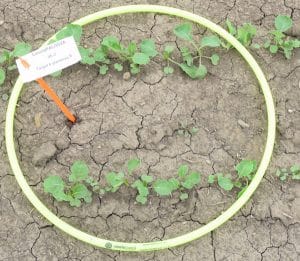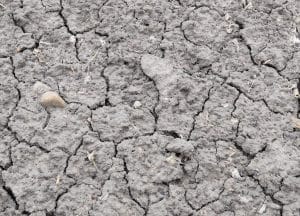Attendees at canolaPALOOZA in Saskatoon, Portage la Prairie and Lacombe could write their own Top 10s and come up with completely different lists from ours. This is ours. Find more from canolaPALOOZA on Twitter. Search the hashtag #canolaPALOOZA17.

1. Do canola plant counts. You can do them right now. It’s not too late. Use these counts to spot uniformity issues and calculate seed survival (using the “plant survival” option for the seeding rate calculator at canolacalculator.ca). Reevaluate stand establishment factors such as consistency of seed depth, seed-placed fertilizer rates, soil temperature and other factors that can influence survival to see what might be done better next year. Also consider how the current plant population may influence management for the rest of the season. With 2-4 plants per square foot, these will need to be protected to maintain yield potential. They will also branch more, which will make timing for fungicide and harvest more difficult. INTERESTING NOTE: Plots at the plant establishment station at canolaPALOOZA in Saskatoon had rows of cotyledon-stage plants among rows of 4-leaf plants. Presenter Murray Hartman, noting the very high seed survival in these late rows, said they were likely seeded too shallow into dry soil and didn’t germinate until the rains came. This would explain the high seed survival. He says seed that went in too deep compared to other rows would probably have much higher seedling mortality.
2. How will you adjust to herbicide-resistant weeds? Heavy reliance on herbicides as the primary weed management tool will mean continued increases in herbicide-resistant weeds by herbicide group, weed species and overall abundance. A key message at the weeds station was that wide rows increase the reliance on herbicides, adding more pressure to the HR weed situation. So do low plant populations and late herbicide applications. Reversing the trend of HR weeds will require improved crop competition and earlier spray applications. The “critical period of weed control” in canola is at or before the 4-leaf stage of the crop.
3. We’ve never sprayed away an insect pest outbreak. The goal with a spray is to focus on immediate threats and economic thresholds for individual fields. If thresholds are reached in a field and the timing is right, then an insecticide spray is often necessary. But forget about trying to tackle a regional outbreak. We’ve never sprayed our way out of a large-scale insect outbreak. In these situations, natural controls…parasitic, viral, fungal…will eventually rein in the population. INTERESTING NOTE: Larvae of brachonid and ichneumonid wasps are beneficial parasitoids of some common pest worms, but the adult wasps require nectar. Therefore, a diverse landscape is required to maintain populations of parasitoids that can help us manage insect pests. Natural and undisturbed spaces also provide for healthy populations of carabid beetles (ground beetles) and rove beetles that feed on diamondback moths, cutworm, bertha armyworm and root maggot.
4. How do we assess flea beetle stem feeding? The most common questions at the insect booth at canolaPALOOZA Lacombe were on flea beetles and stem feeding. We are still not positive on how to assess stem feeding and fit it into the threshold, which is based on leaf-area loss. Next most common were questions on cabbage seedpod weevil, especially why numbers are down so far this year, and on cutworms. As canolaPALOOZA presenter @Abbugcounter said on his Twitter #abbugchat today, cutworms have caused some frustrations this year because of spotty and sometimes severe damage.
5. No need to crowd nutrients in the seed row. This is especially true for canola, which can be sensitive to anything more than around 20 lb./ac. of phosphate in the seed row. Higher phosphate rates or adding sulphur, nitrogen or potassium to the seed row will increase seedling loss. Moisture and high seed-bed utilization can reduce the risk, but growers are better off applying nutrients in a separate earlier pass if side-banding these other nutrients at the time of seeding is not an option. Fall banding can meet crop needs and still adhere to 4R recommendations to limit losses.
6. You can effectively clean a sprayer without 1,000s of gallons of water. At the sprayer cleanout station, presenters noted the two steps to cleaning a sprayer: (1) Diluting the remaining volume in the tank and return plumbing and (2) decontaminating the troublespots like screens and boom ends. The most effective way to dilute the remaining volume is to have as little of it as possible in the first place. Spray out the tank remainder in the field before attempting any dilution. Do not dump it on the ground. Once the tank is empty, the most effective way to dilute the remaining volume is with a series of small volume batch rinses. A triple rinse of 50 gallons, each time running through the agitation and return lines, is much more effective than a single rinse with 150 gallons. This is best done using a clean water tank on the sprayer, and spraying out in the field. The main troublespots for contamination are screens and boom ends, but valves, junctions, elbows and black hoses that feed the booms can also be problem areas. Visually observe all screens and rinse if necessary. Drain boom ends and run clean water through. Use a cleaner and allow it to sit in the lines for as long as possible, then spray out. The cleaner won’t hurt your crop. Know your sprayer plumbing and be sure to also flush any dead sections of plumbing. Setups that will save time and improve cleaning effectiveness are: (a) recirculating booms (b) continuous rinse systems. Consider these innovations to improve your sprayer.
7. When and how to scout for blackleg. Blackleg management decisions start with late season scouting to assess disease incidence and severity on each field. To scout, clip standing canola plants at the stem base late in the season (around swathing time or a few weeks before straight combining) to check for blackening of the stem. This is an indicator of blackleg severity. If blackleg is present, the best tools to keep it from causing yield loss in subsequent years is to extend the rotation to three or four years and switch to a different source of blackleg resistance. A new blackleg labeling program will help. Talk to your seed retailer. (Watch the blackleg video.)
8. Want to dry grain using aeration? Moisture in the air can be as big a factor as moisture in the grain. Basically, for efficiency in-bin drying with natural-air drying, many factors need to be considered, including grain temperature, grain moisture content, air temperature and air moisture content. The bottom line is that unless incoming air is warm (giving it a higher capacity to dry), natural air will have limiting drying capacity. When in doubt, the best bet is probably to run the fan constantly until the safe grain temperature and moisture is achieved. Is this takes too long, supplemental heat will be required. (Read more. The September Canola Digest will have an article with timely information on equilibrium moisture content and how that will influence aeration decisions.)
9. Check your harvest losses. As Trevor Scherman, owner of drop-pan maker ScherGain, said at canolaPALOOZA Saskatoon, it is almost impossible to tell how much canola a combine throws over without doing proper tests under a variety of crop conditions. A display plot at the station had 5 bu./ac. of black canola seeds spread over the ground. These seeds are difficult to spot and impossible to quantify without a drop pan. To put a twist on Les Hill’s line “Just because you can combine at 6 mph doesn’t mean you should”, Scherman said: “Working at 2.8 mph seems too slow for a 600-hp combine, but you never know the right speed and settings until you measure losses.” More from Les Hill.


10. What are the best methods to straight-combine canola? PAMI has recent research on headers and pre-harvest dry down aids for straight combining canola. The header study found that all headers can work for straight combining canola but headers with an extendable cutter bar are best to reduce losses. The one-year pre-harvest aids study showed no statistical difference in yield or quality for the 4 treatments: Reglone, Heat/glyphosate mix, natural ripening and swathing. Treatments were more expensive that natural ripening, but as PAMI’s Lorne Grieger says, “When doing their own economic analysis, producers should consider costs that relate to the ability to schedule and predict harvest timing, ease of harvest and operator experience.” Pre-harvest aids can help in these regards. Read more.


